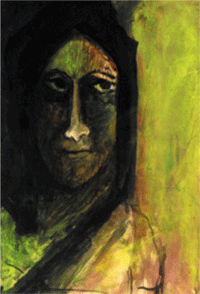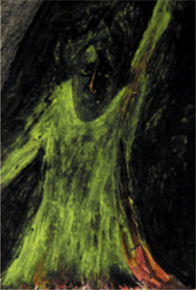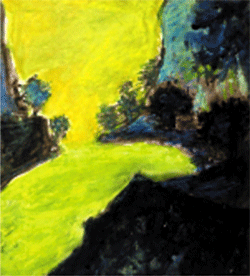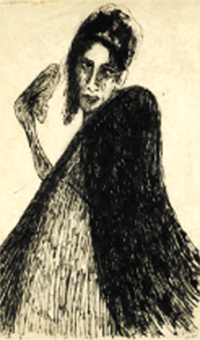- Guest Editor’s Column
- Docedge the Asian documentary forum
- Creative Impulse
- Arts and Crafts Movement : Mission Style Furniture
- Porcelain-enamel Advertising Signs
- Passions run high over the auction of Tagore's paintings
- In the News
- Controversy
- Artist Index and Statistics
- Market Insight
- Auction Reports : What happened
- Auction Reports : what's forthcoming
- Art's eye-view
- The month that was
- Mumbai Artsighting
- Art Bengaluru
- Musings from Chennai
- Deccan Odyssey
- North-East Opsis
- The Wreckage
- Inscription in Bronze
- Black and White
- Nature God
- Indian Highway
- Structures Within an Intervention
- Hard Talk
- Different hues of Aakriti
- Christie’s : Important Watches
ART news & views
Passions run high over the auction of Tagore's paintings
Volume: 2 Issue No: 5 Month: 6 Year: 2010
 Rabindranath & Elmherst |
Gurudev lived in a historical era- that of Indian nationalism- when it seemed possible to reinvent a public role for the poet. Born under a star in the East, the Bengalis who disastrously have a habit of making an oblique entry into his fascinating mind form a cult around him and forget that he was a poet of the world. For him affiliation or worldliness was rather crude a term that makes an attempt to enforce the location of cultural practices into the mundane, the quotidian, and the secular. His elegance was to do with mapping and drawing connections in the world between practices, individuals and civilizations. The poet's huge oeuvre, in which universal and individual are supposedly blended, his theology commits him to a belief in the incarnation of the universal in particular, the Word in the word, even as his disdain for the material world continues unabated. One might, to be sure, see modernism as a belated reinvention of classical unity but he traded in his poetic practice between eternal and the ephemeral. But modernism of the day proved unable to stabilize the relation between the changeless and the contingent in him- a relation which usually turns out to ironic as in the forms of his prose and poetry into archetypal truths. For politicians who use their love for Tagore to cover up their folly and organized rhetoric that otherwise ruled the street, the recent demand (it has unleashed torrents of sentiments) to return Tagore's painting to be put on an auction at Sotheby's next month to Bengal allowed for (relatively) non- violent resolution of internal conflicts in governance and for the inclusion of multiple viewpoints in deliberation over its policy. The long and distinguished history of diatribe against and attacks on the poet by the same clan and total disregard for Tagore's memorabilia is more puzzling. We cannot shed our responsibility by claiming that we live in an apocalyptic time when we lost our first Nobel medallion and still do not have a Gallery of Modern Art in Kolkata but have multiple committees to build one in the future. Perhaps if we have a terrible privilege it is merely that we are alive and are going to die, one at a time leading an irresponsible life. Vikram Bachhawat, Director, Aakriti Art Gallery says ruefully “Empty vessels sound much. If we are so concerned then why don't we create a fund and acquire them back by bidding on them. But before that we should ask our self - Do we have the infrastructure? Remember The Tagore Medallion.”
 Untitled (portrait of a woman) to
be sold at Sotheby's |
A leading national daily, The Telegraph of Kolkata commented on the controversy on 23 May, 2010 “…Common sense would suggest that it is up to the owner of the 12 paintings the Dartington Hall estate in South Devon to decide what they want to do with them. The paintings have been in the Dartington Hall's collection for nearly 71 years, and no one in India has shown the slightest interest in them. The news of the auction has galvanized Mr Bhattacharjee to write to the prime minister to take steps to get the paintings back to India. It would appear that some people have objections to the idea of an auction of Tagore's paintings….Art and its appreciation should not be confined to or determined by national boundaries. No one has ever argued that Matisse's paintings should all come back to France and those of Picasso return to Spain. The plea to get back Tagore's paintings is based on a vague patriotism that sits uneasily with a genuine appreciation of art. Indian art- lovers and collectors (institutions and individuals) should be enabled to participate in the global art market. A further and inevitable question grows out of the colossal indifference towards art in India. A visit to any government museum/gallery in India will show how badly the Indian masterpieces are displayed and preserved. Nowhere are the best practices of international galleries followed. The works of Tagore are perhaps better off in a gallery abroad. At least they will be looked after there. In India, they would gather dust or even disappear, as did his Nobel Prize.”
|
|
Eminent artist Jogen Chowdhury feels “Dartington Hall's main charm and significance revolve around Rabindranath and the paintings fill up its core area. So the argument to raise funds for its upkeep is like Louvre's attempt to sell Monalisa to cut corners. We do not argue the auction of Gurudev's painting at all but this brilliant body of work should be kept in one place rather allowed to be scattered amongst different buyers. It should also be kept in mind that proper preservation should be taken care of. This immensely valuable collection provides us with other images of civilization that we belong to, though anyone can afford it is already living in one. Don't you think its appropriate for the government to create a fund to buy these paintings back at its estimated price which is around a few ceores of rupees?"
|
|
Vaughan Lindsay, Chief Executive Officer of the Darlington Hall Trust, said "Finding the space to exhibit these beautiful works has been a challenge for us and we hope their sale will allow them to be enjoyed to their full potential by a wider audience and hopefully by art lovers on the sub-continent." Tagore visited Darlington on a number of occasions and. in addition to his paintings, Darlington holds a huge archive of photographs, letters and other ephemera relating to the artist and his relationship with Darlington, all of which will remain part of Darlington's extensive archives.
Shuvaprasanna, noted artist reacts " I am really baffled by this sudden emotional and passionate outbursts. This is private property and certainly does not belong to any national institution or university. What saddens me deeply is that Rabindranath's sizeable number of works is presently lying in trunks covered with dust in Rabindra Bharati Society and still remains unexplored to his countrymen. Today the priceless treasure is looked after by people who have nothing to do with art or art history. Rathindranath gifted this to the Society for us, not to allow a coterie to exude power over them. The entire series of “Krishna-leela” by Abanindranath has suffered a similar fate. We should understand heritage can be seen as a 'closed terrain' of few power mongers, or as an apparent 'permanency' which is in fact always a social process and evolution. The choice is for the nation to make. No artist creates work to be buried permanently in stark darkness”.
|
|
Noted historian Pranabranjan Ray says, “Firstly, I think we really do not have anything to do since it's a private collection. We can best appeal that the collection is kept in one place and properly looked after…. it was given to Leonard Elmhirst way back in the 30's long before the paintings were declared a national treasure. He was a long time confidante and friend of the poet and the builder of Sriniketan. Elmhirst became its first Director. The ties between two men were deep knitted and intimate straddling between art, culture, science and farming. We need to appreciate that. On his return to England, Elmhirst established Dartington Hall together with his American wife Dorothy. It remains today a unique edifice of arts and education etched with poet's legacy. Even Supriyo Tagore had gone there and completed a certificate course. In that case should one also argue for the return of the paintings given to Indologist Maurice Winternitz by the poet? Those are now kept in Charles Museum in the Prague University? A collection in a foreign country only adds pride to the nation of origin.” He adds. “I remember the uproar created in the Parliament over the permission given to Andrew Robinson for filming Tagore's paintings in the collection of Vishwa Bharati. Probably the politicians were oblivious of the fact that it's a common practice for museums all over the world to provide reproductions on request to scholars for matters related research and future studies.” Vikram Bachhawat argues”It's their property, legally acquired and if they want to sale, why can't they.”
|
|
Talking about the paintings, Holly Brackenbury, Deputy Director in Indian Art at Sotheby's, comments: “It is very exciting to have the privilege of bringing these 12 museum-quality paintings by one of the key Modern masters of Indian painting to auction this summer. Together they form a stand-out group, and all have impeccable provenance having been in the collection at Dartington Hall for most of their life. Given this exemplary history and also Tagore's stature as one of India's heritage artists, the sale of these paintings really does present collectors with an exceptionally rare, once-in-a-generation acquisition opportunity.”
About Tagore's paintings Nehru curiously observed “Last week I sent you one of Tagore's latest pictures….When he was recovering from his several illness, one day he suddenly got up and started painting…it seems to be symbolical of his return to light from the shadows You see light breaking through the dark forest of trees” (Freedom's Daughter: Letters between Indira Gandhi and Jawaharlal Nehru, 1922-39). His paintings emerged in moments of historical transformation to give birth to Indian Modern Art and made us aware of the recognition that tradition bestows is a partial form of identification. His thoughts were freer and inescapable bearing his strong personal identity, intersecting our lives and minds producing powerful effects on us.
 Untitled (figure in yellow) to be sold at Sotheby's |
This year the nation pays obeisance to Gurudev to mark the poet's 150th birth anniversary to posit a sign beyond any historical enterprise but the politics of the day during an election year probably demands clipped patrician tones to the unbuttoned colloquialisms of our chief minister's plea to return the Elmhirst collection need to cross more than a linguistic boundary. The Master had such an assured command of so many intellectual and creative idioms, that to limit him to our regional sentiments is absolutely unnecessary. Imagine Van Eyck's Portrait of Arnolfini and his wife from National Gallery London, Caravaggio's flute player from St. Petersburg, Raphael's Sistine Madonna or Rembrandt self-portrait with Saskia from Dresden, Bosch's The Garden of Earthly Delights from Prado museum, Madrid be sent back to the respective artist's country? The list is endless. Vikram Bachhawat admits” I will be proud to see our great legends in important museums across the world”. He adds “ Gurudev's repertoire is so large and vast. His songs, novels, poems, plays, paintings- he is like an ocean. A few paintings in the world's greatest museum are more befitting and just”. For us, the lesser mortals, the trauma at the source of intellectual trajectory was Bolshevik terror- but the respective nations that Gurudev and we belong are two different worlds; and this is not simply a matter of delectable difference but of debilitating inequality. Gurudev wrote finely against political tyranny; but the ontological gulf between those of the coterie who could hear his voice deep down in themselves while reading him, and those consigned to the outside darkness that could not. There is a sense of misplaced trust in the entire controversy which seems to be allergic to depths, preferring to stage emotions and externalize its conflicts.
Nanak Ganguly



